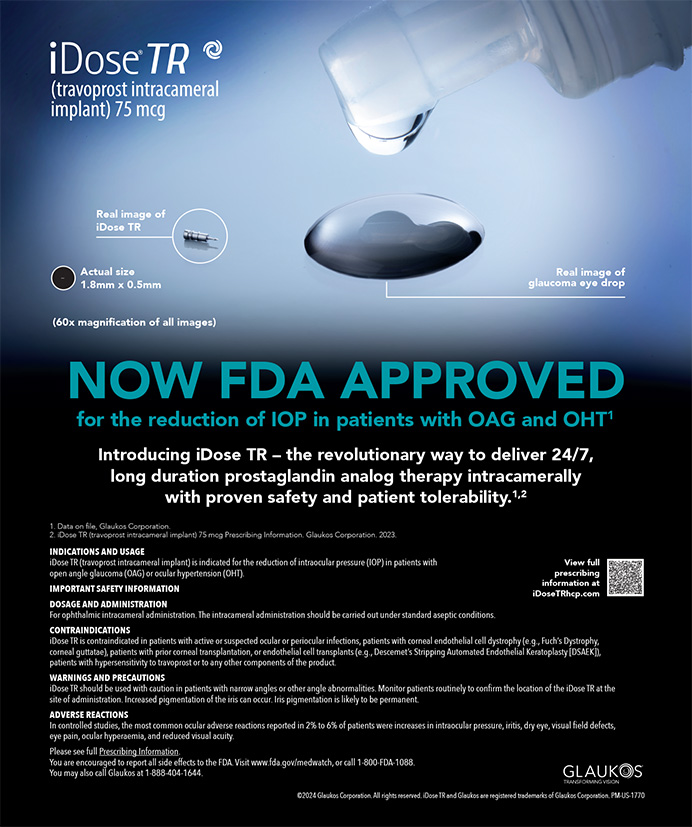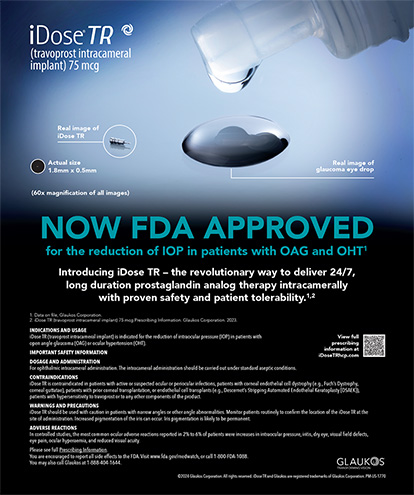
LASIK surgery offers excellent outcomes, with patients routinely achieving 20/20 UCVA or better postoperatively. Despite this fact, the LASIK market has been flat for a decade. The lack of uptake was once widely considered to be the direct result of a flagging economy and a dearth of discretionary income. Although officially the Great Recession ended in June 2009 and signs suggest that the economy is recovering, LASIK volumes have not rebounded—despite improvements in refractive surgery technology, procedures, and outcomes.
Refractive surgeons such as Cary M. Silverman, MD, of EyeCare 2020 in East Hanover, New Jersey, and William B. Trattler, MD, of the Center for Excellence in Eye Care in Miami are among those working to identify what factors are keeping patients from returning to LASIK now that the economy is not suppressing spending. Dr. Trattler reports that his center’s LASIK volume dropped when the economy ran into trouble a decade ago and has remained at a lower level since. Dr. Silverman said he still performs between 20 and 30 LASIK surgeries per month, but he described LASIK as “dead” in his practice based on his rate of 100 to 120 cases per month during the LASIK boom years.
When stakeholders in laser vision correction speculate on whether and when the market will rebound, they typically look at labor statistics, consumer confidence, refractive error trends, and referral behavior, among other things. LASIK procedures in the United States peaked in 2007 at roughly 1.4 million per year, according to industry market research firm Market Scope. The recession started that year, and LASIK volume began a slow but steady decline. At the start of 2015, US consumer confidence was the highest it has been since 2007, according to The Wall Street Journal, and unemployment currently hovers around 5.5%, compared with 9.3% just 5 years ago. Yet, according to Market Scope, US LASIK volume in 2014 was an anemic 650,000 procedures.
If consumers now have jobs and money, why is this not reflected in the LASIK surgery suite? CRST asked a number of key opinion leaders in the fields of refractive surgery and vision correction to weigh in on what factors are holding back the LASIK market and what patients are doing instead.
FASHION FRAMES
LASIK numbers are certainly not declining because fewer people need refractive correction. From 1971 to 2004, the prevalence of myopia in the United States increased by 66%.1 Today, myopia affects one in three individuals in America between the ages of 12 and 54 years.2 According to the Vision Council, which gathers data on matters related to eyewear, there are 182.6 million users of vision correction in the United States; vision correction includes all reading glasses, contact lenses, and spectacles for the correction of refractive error.
It appears that the decline in LASIK volume was not paralleled by a decline in sales of fashion eyewear. In its most recent statistics report, the Vision Council noted that total eyewear sales grew in 2014 and are on track to continue rising in 2015.3
The eyewear market as a whole has an annual growth rate of approximately 3% to 6%, said Joseph Casorio, principal of Vision Associates, a New Jersey-based optical management and consulting company. “The eyewear market has become a fashion-oriented market, even more so than in the past,” he said. “Even the younger population accessorizes with fashion-forward eyewear, owning multiple pairs.
Robust sales of fashion frames reflect this trend. Luxottica, the Italian fashion eyewear behemoth, reported a rise in 2014 revenues by 4.6% to $8.9 billion. Luxottica and other fashion eyewear manufacturers continue to work with fashion designers to develop frames that are the equivalent of wearable art and to market them to aspirational buyers.
Online eyeglass sales are also increasing. The online eyeglass company Warby Parker has convinced many consumers to bypass brick-and-mortar dispensaries by buying spectacles online. The 4-year-old company does not disclose financial information, but it reportedly recently sold its 1 millionth pair of eyeglasses.
Is it possible that the popularity and pervasiveness of fashion frames are helping to stymie a LASIK market that should be rebounding? David Geffen, OD, of Gordon-Weiss-Schanzlin Vision Institute in San Diego said that, although LASIK numbers remain flat, he does not believe that fashion frames are keeping the numbers low. Rather, he suspects that cost is responsible.
“Frames have become more trendy and fashionable, which is why people are more willing to wear their glasses, and some are even opting out of contact lenses for this,” Dr. Geffen said. “However, I still think most people would rather not be dependent on glasses. But, millennials do not have the income their baby boomer parents have, so unless their parents are paying, they cannot afford the surgery.”
Mr. Casorio suggested the slump may have to do with market saturation: “When LASIK first emerged, there was an unserved demographic, which built up demand. You could parallel the same phenomenon with the advent of the iPad [Apple]. After approximately 5 years on the market, the tablet market is flat. Those who truly benefit from LASIK, such as high myopes or those whose lifestyle or career is hampered by corrective eyewear, are still motivated to seek LASIK correction, and there will always be patients who truly do not like to wear glasses.”
Derek Cunningham, OD, director of optometry and research at Dell Laser Consultants in Austin, Texas, and a chief medical editor of AOC said he doubts that surging spectacle sales are responsible for a lackluster laser vision correction market. “Sales margins have been increasing for high-end frames, and this is a growing trend, but I do not think that this has been a large factor [in LASIK volume],” he said. “It no doubt has had some small effect, but historically, the contact lens intolerance market has been a key driver of LASIK. If people want to wear glasses, they should do it because they want to, not because they have to. No matter how cool prescription glasses are, they are still a handicap, and I can’t think of many handicaps that people want.”
COST CONSIDERATIONS
Cost is consistently cited as a possible factor in the low-volume trend in LASIK procedures. John A. Hovanesian, MD, a cataract and refractive surgeon at Harvard Eye Associates in Laguna Hills, California, said that, although there are a variety of causes for LASIK’s ongoing slump, cost is likely the leading factor.
“I think LASIK needs to be about half as expensive as it is for us to see the market significantly move,” he said. “Typically, as technology gets better, it gets less expensive, but what we’ve seen with LASIK is that the price has stayed more or less stable. People often debate this issue with me, saying that, any time LASIK prices are reduced, the volume tends to come down as well. But, I believe that this correlation is because of other factors. For instance, the economy was down when prices came down, so LASIK volume was also down, because people just couldn’t afford it.”
Dr. Hovanesian said the low volume is due to the law of supply and demand. “There’s still a decent LASIK market; the procedure is still being done,” he said. “It’s just difficult for surgeons to lower their prices significantly, because the lasers still cost a lot, and there are significant costs associated with doing the surgery.” Perhaps if those costs were lower, surgeons could adjust their prices, and the demand side of the equation would sync with the supply side, he suggested.
CONTACT LENS CONNECTION
More than 30 million Americans wear contact lenses, according to the American Optometric Association, and this correction modality reportedly generates approximately $2.1 billion in revenue annually. As contact lens technology improves, patients are increasingly recommitting to contacts instead of making the leap to laser vision correction, according to several sources interviewed for this article.
Michael Rebarchik, OD, of Sussex Eye Center, with four locations in Delaware, said fashion frames have nothing on contacts as far as penetration into the potential LASIK market. “If anything, I think the advent of new and improved contact lenses would hurt LASIK business more than fashion eyewear,” he said. “More and more daily disposables are emerging in expanded parameters, allowing patients to experience all of the benefits of contact lenses with little to no hassle in their daily lives, while providing improved comfort as well.”
Dr. Trattler, too, said improvements in contact lenses are an important piece of the puzzle. “The eligibility for a LASIK candidate was much wider back in 2000,” Dr. Trattler said. “Then, surgeons started narrowing down who they considered to be an appropriate LASIK candidate between 2001 and 2003. This resulted in a higher percentage of patients being ineligible for LASIK. In 2015, there are improved technologies and tools to identify corneal conditions and ocular surface issues that may have an impact on LASIK results. Some patients may be eligible for treatment of their ocular condition and later undergo LASIK. On the other hand, these technologies may identify patients who are not candidates for LASIK, which has driven the numbers down further.”
OTHER FACTORS
Other reasons for the decline in LASIK volumes include the increasing recognition of the limits of the procedure’s indications. “Our net for LASIK candidates was much wider back in 2000,” Dr. Trattler said. “In general, back then, we thought everybody was an appropriate candidate. Then we started narrowing down who would be a good candidate around 2001 to 2003, and we ruled out a lot of people. Now, we have better technology and tools to identify corneal conditions and ocular surface issues even earlier to try to ensure that we don’t get poor outcomes, but that also drives down the numbers.”
At the time of this interview, Dr. Silverman said he was about to start a social media campaign aimed at identifying what millennials want, with the aim of rebuilding the LASIK portion of his practice. “At this point, I can’t explain what’s suppressing the market,” he said. “It’s obviously not the economy anymore. It must be a change in the targeted patients’ needs, wants, desires, and maybe their personal economic situation. For instance, many millennials are still living at home with mom and dad. Maybe this demographic needs to be addressed differently, or they have different priorities. Refractive cataract surgery and refractive lens exchange with femtosecond laser is taking off for me. I do 70% of my cataracts with [a] femtosecond laser—90% this past month—and this is an out-of-pocket expense similar to LASIK pricing. The difference is that it is targeted to baby boomers, the same patient cohort that accepted LASIK at its peak.” The only way to bring millennials in for LASIK is to find ways to understand and better address their generational mindset, Dr. Silverman said.
THE YEAR 2020
Cataract and refractive surgeon Richard L. Lindstrom, MD, of Minnesota Eye Consultants in Minneapolis said he sees pricing factors pushing patients away from LASIK and toward contact lenses as an alternative. He describes a patient who would like to make the leap to LASIK but cannot swing it financially. “The typical millennial is in debt and underemployed, so $400 per year for contacts is more affordable than $4,000 for LASIK,” he said.
Dr. Lindstrom is still bullish on LASIK, however, and he said a comeback is not far off. The basis of his optimistic prediction is what he called the “vision lifeline” of the typical millennial. “The critical patients for LASIK today are the millennials, who are 16 to 36 years of age, with the median age being 26,” he said. “The mean age for LASIK is 39, and the millennial is not there yet. They wear glasses until their teens; then, they wear contact lenses into their 30s. Then, they’ll move on to LASIK.”
He sees evidence of this trend in the currently strong contact lens market. “The contact lens market is growing and has heavily penetrated into the millennials, suggesting there are many who are looking for an alternative to glasses,” Dr. Lindstrom said. “The LASIK market will expand when the medial millennials are in their 30s, which is about 4 years away, around the year 2020.”
1. Vitale S, Sperduto RD, Ferris FL 3rd. Increased prevalence of myopia in the United States between 1971-1972 and 1999-2004. Arch Ophthalmol. 2009;127(12):1632-1639.
2. Zadnik K, Sinnott LT, Cotter SA, et al; Collaborative Longitudinal Evaluation of Ethnicity and Refractive Error (CLEERE) Study Group. Prediction of juvenile-onset myopia [published online ahead of print April 2, 2015]. JAMA Ophthalmol. doi: 10.1001/jamaophthalmol.2015.0471.
3. US Optical Market Overview & Outlook: 4th Quarter 2014. The Vision Council. http://www.thevisioncouncil.org/sites/default/files/research/2015-VEE-TVC-Stats-Commitee-Presentation-SK-RK-Combined.pdf. Accessed April 27, 2015.
Rochelle Nataloni
• freelance medical writer with 25 years’ experience specializing in eye care, aesthetics, and practice management
• (856) 401-8859; rnk2020@comcast.net; Twitter @JustRochelleN; www.linkedin.com/in/rochellenataloni


